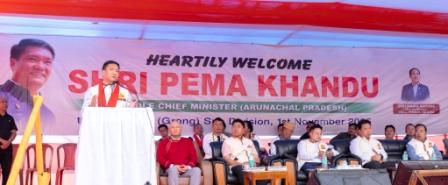-
 Khandu talks tough on alleged Frontier Highway land compensation scam
Khandu talks tough on alleged Frontier Highway land compensation scam
-
APCC raises security concerns in TCL with Guv ahead of…
-
Workshop highlights pangolin conservation efforts
-
 Raj Bhavan celebrates State, Union Territory Foundation Day
Raj Bhavan celebrates State, Union Territory Foundation Day
-
Student found dead under mysterious circumstances at Niglok Sainik School
-
ABVP Arunachal Pradesh Inaugurates 13th State Conference
-
Two arrested with contraband substance
-
Mebo school ordered to shut down over sexual assault probe;…
-
Outreach programme on gender issues
-
APLA bids farewell to retiring staff
The long wait for the new indirect tax rates that will apply to thousands of goods and services is finally over. The Goods and Services Tax Council that met in Srinagar has released details of the rates at which over 1,200 goods will be taxed when the GST regime takes effect. The rate fitment process has been a subject matter of speculation for months now, accompanied by fears that the new tax rates and slabs would be influenced by special interest lobbies. So it is welcome that the government has offered better clarity.
The July 1 rollout of the tax also looks more likely now with the GST Council showing its intent to get things going. Under the new structure, judging from the initial list of 1,211 items, the predominant share (43%) of goods will be taxed at 18%, while 17% and 14% of the notified items will fall under the 12% and 5% tax rate slabs, respectively. Around 7% of the items, which include essential goods such as milk, fruits, cereals and poultry, have been exempted from all taxes. A significant share (19%) of goods, however, has been tucked under the highest tax slab of 28%: many of these cater to the daily needs of the growing middle class. Apart from these four regular tax slabs, additional cess taxes of varying rates have also been imposed on sin and luxury goods such as pan masala, cigarettes and sport utility vehicles to compensate the States for loss of revenue during the initial years.
Winners and losers are sure to emerge as tax rates undergo a major revision. But overall, the government has said the new tax regime will be revenue-neutral. If so, the GST’s influence on private spending will possibly remain muted. The four-slab structure of the GST regime gives it the look of a progressive tax code, in contrast to similar consumption-based taxes prevalent in other countries, which are essentially simple, flat taxes. While progressive taxes may be justified given the wide disparities in income levels in India, the principle of simplicity is being compromised. The new tax regime disappoints on earlier expectations that the top tax rate would be capped below 20% too. The middle class will now have to bear the brunt of higher prices. The challenge going forward will be to prevent backdoor rigging of rates through additional levies that are completely discretionary. States that have added significantly to their debt burden in recent years must be kept in check. Or additional discretionary taxes would add to the overall tax burden and particularly compromise on tax predictability. Lastly, the Centre and States must keep their pressing fiscal demands from influencing tax rates upwards in the future. Otherwise, the decision to do away with tax competition among States, in favour of a simple centralised tax system, will be done no justice. (With Inputs)

Kenter Joya Riba
(Managing Editor)She is a graduate in Science with post graduation in Sociology from University of Pune. She has been in the media industry for nearly a decade. Before turning to print business, she has been associated with radio and television.
Email: kenterjoyaz@easternsentinel.in / editoreasternsentinel@gmail.com
Phone: 0360-2212313

